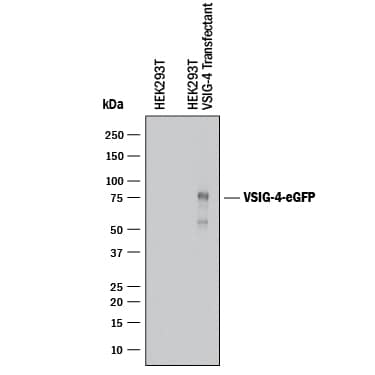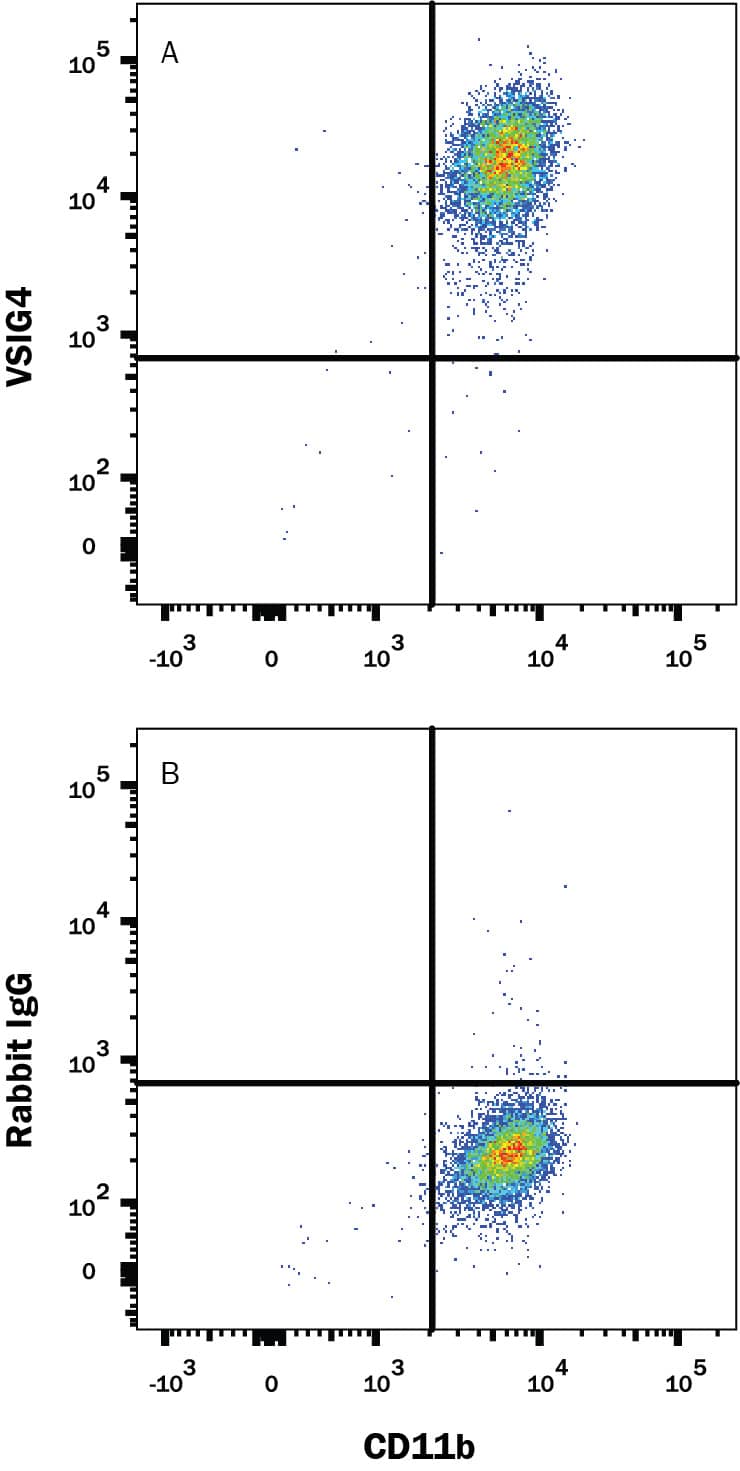Human VSIG4 Antibody
R&D Systems, part of Bio-Techne | Catalog # MAB46461
Recombinant Monoclonal Antibody.


Conjugate
Catalog #
Key Product Details
Species Reactivity
Validated:
Human
Cited:
Human
Applications
Validated:
Flow Cytometry, Western Blot
Cited:
ELISA Capture
Label
Unconjugated
Antibody Source
Recombinant Monoclonal Rabbit IgG Clone # 2174B
Product Specifications
Immunogen
Mouse myeloma cell line NS0-derived human VSIG4
Arg20-Pro283
Accession # Q9Y279
Arg20-Pro283
Accession # Q9Y279
Specificity
Detects human VSIG4 in Western blots.
Clonality
Monoclonal
Host
Rabbit
Isotype
IgG
Scientific Data Images for Human VSIG4 Antibody
Detection of Human VSIG4 by Western Blot.
Western blot shows lysates of HEK293T human embryonic kidney cell line (wild type) and HEK293T human embryonic kidney cell line transfected with human VSIG4. PVDF membrane was probed with 2 µg/mL of Rabbit Anti-Human VSIG4 Monoclonal Antibody (Catalog # MAB46461) followed by HRP-conjugated Anti-Rabbit IgG Secondary Antibody (HAF008). A specific band was detected for VSIG4 at approximately 75 kDa (as indicated). This experiment was conducted under reducing conditions and using Western Blot Buffer Group 1.Detection of VSIG4 in Human Macrophages by Flow Cytometry.
Human CD14+ PBMCs (MAGH105) cultured with 50 ng/ml recombinant human M-CSF (216-MC) and 10 μM Hydrocortisone (4093) for 7 days to generate macrophages were stained with (A) Rabbit Anti-Human VSIG4 Monoclonal Antibody (Catalog # MAB46461) or (B) Rabbit IgG isotype control antibody (MAB1050) followed by anti-Rabbit IgG Allophycocyanin-conjugated secondary antibody (F0111) and Mouse Anti-Human CD11b Phycoerythrin-conjugated Monoclonal Antibody (FAB16991P). Staining was performed using our Staining Membrane-associated Proteins protocol.Applications for Human VSIG4 Antibody
Application
Recommended Usage
Flow Cytometry
0.25 µg/106 cells
Sample: Human CD14+ PBMCs (Catalog # MAGH105) cultured with 50 ng/ml recombinant human M-CSF (Catalog # 216-MC) and 10 μM Hydrocortisone (Catalog # 4093) for 7 days to generate macrophages
Sample: Human CD14+ PBMCs (Catalog # MAGH105) cultured with 50 ng/ml recombinant human M-CSF (Catalog # 216-MC) and 10 μM Hydrocortisone (Catalog # 4093) for 7 days to generate macrophages
Western Blot
2 µg/mL
Sample: HEK293T human embryonic kidney cell line transfected with human VSIG4
Sample: HEK293T human embryonic kidney cell line transfected with human VSIG4
Formulation, Preparation, and Storage
Purification
Protein A or G purified from cell culture supernatant
Reconstitution
Reconstitute at 0.5 mg/mL in sterile PBS. For liquid material, refer to CoA for concentration.
Formulation
Lyophilized from a 0.2 μm filtered solution in PBS with Trehalose. *Small pack size (SP) is supplied either lyophilized or as a 0.2 µm filtered solution in PBS.
Shipping
Lyophilized product is shipped at ambient temperature. Liquid small pack size (-SP) is shipped with polar packs. Upon receipt, store immediately at the temperature recommended below.
Stability & Storage
Use a manual defrost freezer and avoid repeated freeze-thaw cycles.
- 12 months from date of receipt, -20 to -70 °C as supplied.
- 1 month, 2 to 8 °C under sterile conditions after reconstitution.
- 6 months, -20 to -70 °C under sterile conditions after reconstitution.
Background: VSIG4
References
- He, J.Q. et al. (2008) Mol. Immunol. 4041.
- Vogt, L. et al. (2006) J. Clin. Invest. 116:2817.
- Langnaese, K. et al. (2000) Biochim. Biophys. Acta 1492:522.
- Helmy, K. et al. (2006) Cell 124:915.
- Entrez protein Accession # EAX05393, NP_001093901, CAI42052, CAI4205, EAX05394.
- Tanaka, M. et al. (2008) Clin. Exp. Immunol. 154:38.
- Lee, M.Y. et al. (2006) J. Leukoc. Biol. 80:922.
- Gorgani, N.N. et al. (2008) J. Immunol. 181:7902.
- Walker, M.G. (2002) Biochim. Biophys. Acta 1574:387.
- Wiesmann, C. et al. (2006) Nature 444:217.
- Katschke, K.J. et al. (2007) J. Exp. Med. 204:1319.
- Small, A.G. et al. (2016) Swiss Med Wkly. 5:146.
- Roh J. et al. (2017) Oncotarget. 8:58122.
- Kim K.H. et al. (2016) Autophagy. 12:1647.
Long Name
V-Set and Immunoglobulin Domain Containing 4
Alternate Names
Z39IG
Gene Symbol
VSIG4
UniProt
Additional VSIG4 Products
Product Documents for Human VSIG4 Antibody
Product Specific Notices for Human VSIG4 Antibody
For research use only
